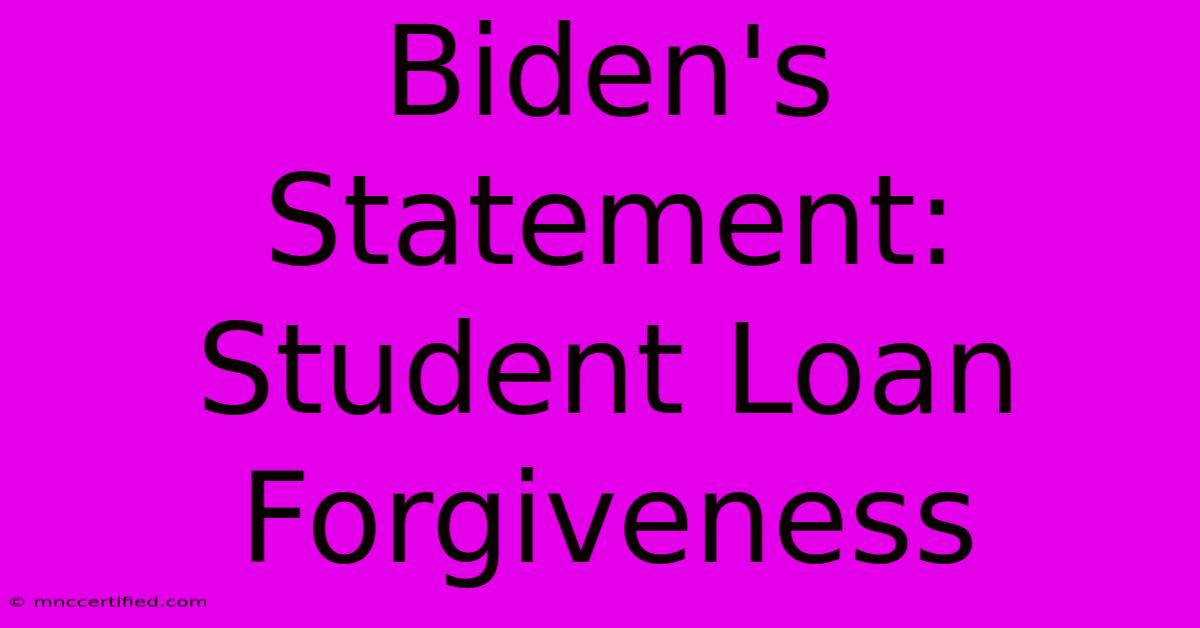Biden's Statement: Student Loan Forgiveness

Table of Contents
Biden's Statement on Student Loan Forgiveness: A Comprehensive Overview
President Biden's plan for student loan forgiveness has been a highly debated topic, sparking significant discussion regarding its economic impact, legal challenges, and its effect on borrowers. This article delves into the details of Biden's statement, exploring the key aspects of the proposal, the arguments for and against it, and its potential consequences.
Understanding the Plan: Key Features of Biden's Student Loan Forgiveness Initiative
Initially, the Biden administration announced a plan to provide student loan forgiveness of up to $20,000 for Pell Grant recipients and $10,000 for non-Pell Grant recipients. This initiative targeted borrowers facing significant financial burdens due to student loan debt. The plan aimed to alleviate this burden and stimulate the economy by freeing up disposable income for borrowers. Crucially, the income limits were set at $125,000 for individuals and $250,000 for married couples. This aimed to target those most in need, while preventing those deemed higher earners from benefiting from the program.
Eligibility Criteria: Who Qualified for Loan Forgiveness?
Eligibility for Biden's student loan forgiveness program hinged on several crucial factors:
- Income Limits: As mentioned above, borrowers needed to earn less than $125,000 annually (or $250,000 for married couples).
- Loan Type: The forgiveness applied to federal student loans, excluding Parent PLUS loans.
- Pell Grant Status: Pell Grant recipients received a higher amount of forgiveness ($20,000) compared to non-recipients ($10,000).
Arguments For and Against Student Loan Forgiveness
The debate surrounding Biden's student loan forgiveness plan is multifaceted, with strong arguments on both sides.
Arguments in Favor:
- Economic Stimulus: Proponents argued that forgiving student loan debt would inject billions of dollars into the economy, boosting consumer spending and stimulating economic growth. This increased spending power would, in turn, lead to job creation and economic recovery.
- Social Equity: The plan aimed to address the racial and socioeconomic disparities in access to higher education. Historically marginalized groups have disproportionately faced higher levels of student loan debt.
- Reduced Financial Burden: For millions of borrowers struggling with student loan repayments, forgiveness offered significant financial relief, allowing them to focus on other financial priorities like housing, healthcare, and family expenses.
Arguments Against:
- Cost to Taxpayers: Critics argued that the program's cost, estimated to be in the hundreds of billions of dollars, would be a significant burden on taxpayers. They questioned the fairness of using taxpayer money to forgive the debts of others.
- Inflationary Concerns: Some economists voiced concerns that the influx of money into the economy through loan forgiveness could fuel inflation, potentially eroding the purchasing power of the dollar.
- Moral Hazard: Opponents argued that forgiving student loans could create a moral hazard, discouraging future responsible borrowing and potentially increasing tuition costs as universities anticipate government bailouts.
- Legal Challenges: The legality of the plan faced considerable scrutiny. Legal challenges questioned the authority of the executive branch to implement such a sweeping program without congressional approval.
The Aftermath and Ongoing Debate
The Supreme Court ultimately struck down Biden's plan, halting the initiative and leaving millions of borrowers without the promised debt relief. This decision reignited the debate surrounding the role of government intervention in student debt and the need for alternative solutions to address the growing problem of student loan debt in the United States. The long-term implications of this ruling remain to be seen, however, alternative strategies to assist struggling borrowers are now under consideration. This includes targeted relief programs and expanded income-driven repayment options.
Conclusion: The Future of Student Loan Forgiveness
President Biden's statement on student loan forgiveness represented a bold attempt to tackle a significant societal problem. While the Supreme Court decision halted the initial plan, the underlying issues of student debt remain. The debate continues, with various stakeholders proposing alternative solutions to alleviate the burden of student loan debt and ensure greater access to affordable higher education. The ongoing discussion underscores the complexity and urgency of finding effective, equitable, and sustainable strategies to manage the student loan crisis in the U.S.

Thank you for visiting our website wich cover about Biden's Statement: Student Loan Forgiveness. We hope the information provided has been useful to you. Feel free to contact us if you have any questions or need further assistance. See you next time and dont miss to bookmark.
Featured Posts
-
New Deal For Olutayo Subuloye
Dec 21, 2024
-
Microneedle Devices Pharmas Future
Dec 21, 2024
-
Biden Harris Announces 37 Million In Grants
Dec 21, 2024
-
Uk Ireland Box Office Mufasas Lion King Debut
Dec 21, 2024
-
Lawsuit Filed Against Haliey Welch
Dec 21, 2024